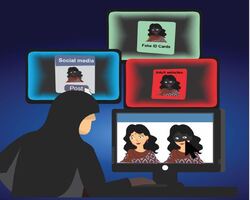

Imagine a young girl posts her graduation photo on Instagram. A week later, a morphed version of that image starts circulating in WhatsApp groups—with explicit alterations and lewd messages. She begins receiving blackmail messages from strangers. Her family is devastated. And the police? You—her first line of defense—must now track an invisible enemy.
This is the world of online morphing. And it's rising fast.
Morphing—digitally altering images to distort reality—is now a favored weapon of cybercriminals. For law enforcement, understanding this threat is not optional. It’s urgent.
What Is Morphing? Why Should Policemen Care?
Morphing is the act of altering or merging facial or body features in a photo or video using software like Photoshop or AI-based tools. The result? A fake—but realistic—image used to:
- Create obscene content
- Generate fake social media profiles
- Commit identity theft
- Blackmail victims (especially women and minors)
Reality Check:
- Over 1,800 cases of cyber blackmail and sexual harassment were reported in India in 2022 related to image morphing.
- NCRB data shows a 35% increase in cyber harassment cases against women and children in the past two years.
- AI-powered deepfake tools can now produce fake images in under 30 seconds—and most are free to use online.
How Are Morphing Crimes Committed?
Let’s break down the typical modus operandi:
- Image Collection: Scammers scrape public images from Facebook, Instagram, WhatsApp, or school websites.
- Digital Editing: Photos are altered using editing apps or AI tools like FaceApp, Reface, or deepfake generators.
- Distribution & Blackmail:
- Uploaded to pornographic sites
- Sent directly to the victim’s contacts
- Used to extort money or favors
- Fake Profiles: Criminals create fake identities using morphed images to trap others—particularly teenagers and women.
Impact on Victims: More Than Just a Photo
As police officers, it's crucial to understand the psychological and social damage victims suffer:
- Mental health trauma: anxiety, depression, PTSD
- Loss of dignity and reputation
- Social isolation and fear
- Increased risk of suicide among teens and young adults
In a 2021 survey by the Internet Freedom Foundation, 72% of female respondents said they avoided posting pictures online due to fear of misuse.
How Policemen Can Prevent Morphing Incidents
This crime needs prevention and intervention. Here’s what law enforcement officers can do at both levels:
1. Educate the Community Proactively
Host cyber awareness workshops in schools, colleges, and local communities.
- Teach youth, especially girls, to keep social media profiles private.
- Explain the risks of sharing selfies, even with close friends.
- Encourage the use of watermarks on personal photos.
2. Promote Digital Hygiene
Push for secure online behavior:
- Two-factor authentication
- Strong, unique passwords
- Avoiding cloud backups of private photos
3. Train Yourself & Your Team
Stay updated with:
- Image morphing tools and trends
- Reverse image search techniques (e.g., Google Lens, Yandex)
- AI deepfake detection platforms
4. Collaborate with Tech Platforms
Encourage citizens to:
- Use “Report” options on Facebook, Instagram, and X (formerly Twitter)
- Block and restrict suspicious profiles As police, collaborate with platform authorities during investigations for quick image takedowns.
When A Victim Approaches You: Step-by-Step Action Plan
Here’s how to respond swiftly and sensitively:
Step 1: Record Their Statement with Empathy
- Create a victim-safe environment.
- Let them explain without interruption.
- Avoid judgmental remarks.
Step 2: Collect Digital Evidence
Ask the victim to:
- Share screenshots of the morphed images
- Provide the URLs or usernames of fake profiles
- Hand over emails or chats related to blackmail
Step 3: File an FIR
Applicable IPC/IT Act Sections:
- Section 66E (IT Act) – Violation of privacy
- Section 67/67A (IT Act) – Publishing obscene material in electronic form
- Section 354C (IPC) – Voyeurism
- Section 509 (IPC) – Insulting the modesty of a woman
- POCSO Act – If the victim is a minor
Step 4: Forward to Cyber Cell
- Preserve metadata and server logs
- Reach out to CERT-In if hosted on foreign platforms
- Contact ISPs to trace IPs if needed
Step 5: Report to Social Media Platforms
You or the victim can:
- Lodge complaints via platform’s “Help Center”
- Use Grievance Officers' contacts (mandated under IT Rules 2021)
Preventive Tips Policemen Must Share with Public
|
Tip |
Reason |
|
🔒 Keep profiles private |
Limits access to images |
|
📸 Avoid face-focused selfies |
These are easier to morph |
|
🛡️ Use watermarks on photos |
Prevents unauthorized reuse |
|
🚫 Don’t share intimate content |
Even with trusted friends or partners |
|
🧑⚖️ Know your rights |
Awareness helps faster action |
Real Case Study: Morphing and Blackmail in Kerala
In 2023, a 17-year-old schoolgirl from Thrissur faced blackmail after her edited photo appeared on a pornography site. The culprit was traced to a teenager who had received her photo via WhatsApp, morphed it, and uploaded it to Reddit-like platforms.
The cybercrime police unit acted within 72 hours, taking down the image, arresting the boy, and counseling both families.
Why was the case successful?
- Prompt reporting by the girl’s parents
- Swift FIR registration
- Active cyber patrolling by the police
Technology That Can Help Policemen
|
Tool |
Use |
|
🕵️♂️ Google Reverse Image Search |
To track photo origins |
|
🔍 FotoForensics |
Analyzes image manipulation |
|
🛡️ Deepware Scanner |
Detects deepfake videos |
|
📊 InVID Tool |
Verifies authenticity of visual content |
|
🧑💻 Indian Cybercrime Reporting Portal (cybercrime.gov.in) |
For complaint registration |
✅ Summary: Your Role in the Digital Battlefront
Policing today is no longer limited to the streets—it extends to Instagram, Telegram, and anonymous forums. Morphing is not just an online prank—it’s a serious cyber offense that can ruin lives.
As a policeman, your role includes:
- Educating society
- Enabling safe reporting
- Acting swiftly and with sensitivity
- Bringing perpetrators to justice
- Supporting victims through trauma
In a world where photos speak louder than words, your silence as a protector must never echo.
Cyber Hygiene Foundation
- CyberAwareness CyberSafety PersonalDataProtection SafeInternetForAll CyberHygieneForAll DigitalSecurityLaw NetworkDefense ITSecuritySolutions
You May Also Like It
Understanding the Growing Threat of Loan Frauds Loan frauds have become
In your role as protectors of law and order, you
Leave A Comment
Don’t worry ! your e-mail address will not published.








0 Comments